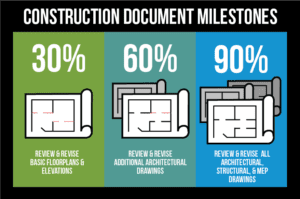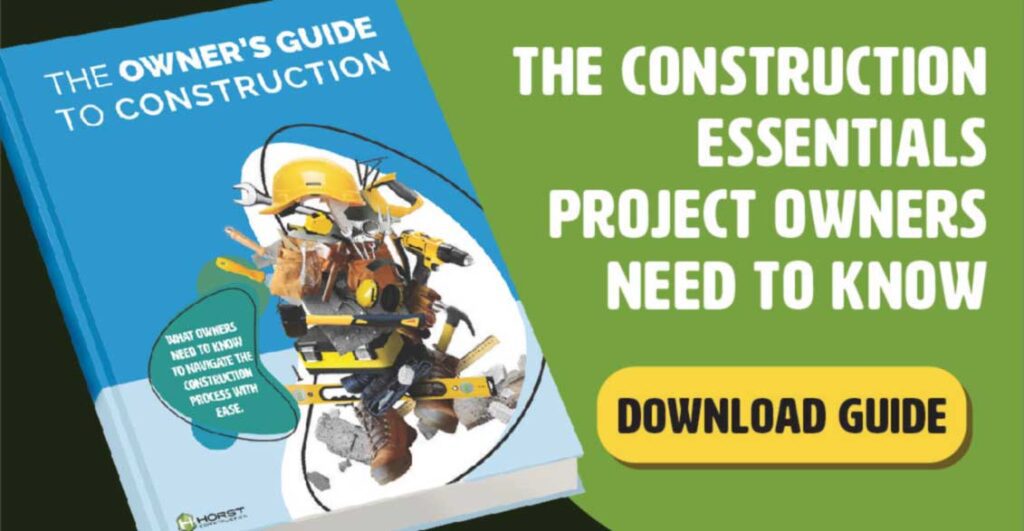 Getting to see your project visually represented for the first time on drawings is an exciting time! It is often the first time your ideas and hard work to get to this stage take shape and feel tangible. Unfortunately, some people are surprised to learn that the first set of drawings may not be as detailed as they might expect.
Getting to see your project visually represented for the first time on drawings is an exciting time! It is often the first time your ideas and hard work to get to this stage take shape and feel tangible. Unfortunately, some people are surprised to learn that the first set of drawings may not be as detailed as they might expect.
For most projects, design teams follow the 30-60-90 issued for construction (IFC) approach for developing and sharing the project’s drawings.
WHAT IS THE 30-60-90 DESIGN PROCESS?
The phase of the project known as the “construction documents phase” is generally split into thirds. Each milestone marks an important step towards the start of construction and helps to unfurl your project’s intricacies and needs. This is known as the 30-60-90 IFC process.
It’s broken into the following three steps:
- Step 1 – 30% Drawings: Develop and then review the basic architectural floor plan and elevations
- Step 2 – 60% Drawings: Develop and then review additional architectural drawings and confirm all revisions from the 30% drawings were made
- Step 3 – 90% Drawings: Develop and then review additional architectural and structural drawings; develop and review mechanical, electrical, and plumbing drawings; and confirm all comments on the 60% drawings were acknowledged
By creating and releasing the documents in phases, the project team maintains a clear and focused approach to each consideration in the project’s design. The approach prevents the team from getting overwhelmed by too much detail, allowing timely discussions and course corrections at each stage.
So, what can you expect during each phase? And how can you ensure the review process is productive and efficient? Read on to find out.
30% DESIGN DOCUMENTS
While the specifics will vary for each project, the overall purpose of 30% design documents is pretty much universal. This phase aims to lay out the major design elements of your project and establish a cost and timeline.
Along with the drawings, the project’s scope, schedule, and budget will be fine-tuned in this stage. The project manager will develop and commit to a baseline schedule, baseline budget, and baseline cost estimate.
During this phase, the project team will have the opportunity to review the “base layer” or “big picture” version of the drawings. Free from the nitty-gritty details, it will be easier to look critically at the bones of the project without getting bogged down by detail.
Overall, the 30% design phase is the foundation upon which the project’s design will sit. Taking the time to carefully analyze the drawings and provide thoughtful feedback will pay off as the design continues to develop.
60% DESIGN DOCUMENTS
Once the revisions from review discussions during the 30% design phase have been made, the architect will issue the next set of documents – the 60% design documents.
During this round, the project team will focus on analysis of constructability, budget considerations and modifications, and potential issues or concerns.
The team will discuss the constructability of the drawings and any preferred equipment and materials needed to build the project during this stage. Now is also the time to consider permit requirements, looking for any issues in the design that may need to be changed before permitting is issued.
This phase is also a good time for value engineering because the impact on schedule and overall design is lowest – meaning less costly and more efficient. While value engineering can happen after this stage, changes in later stages can be more costly and time-consuming once the wheels are in motion.
In addition to the 60% drawings, a preliminary construction schedule, phasing plan, and logistics plan should be drafted and shared with the project team.
90% DESIGN DOCUMENTS
Once the revisions from the 60% design stage are made, the design team will issue the 90% design documents. These should include all the plans and specifications for the project. Once completed, these are submitted for permitting review.
While this set should closely represent the final project, modifications could be required for permitting or code considerations.
Additionally, the construction schedule, phasing plan, and logistics plan will be finalized.
3 TIPS FOR A SUCCESSFUL DESIGN DOCUMENT REVIEW
1. Document the Meetings
For most owners, maintaining the project’s budget is a sticking point. However, it’s easy for the budget to fall by the wayside when reviewing designs and proposing changes. While small changes here and there may not seem to have a big impact, they can add up. This is known as scope creep.
Ensure someone is keeping thorough meeting minutes and other documentation of the discussions. These will help keep scope creep at bay and provide detailed notes to refer to if needed.
2. Keep the Project’s Vision in Focus
When a group of people is evaluating small details, it’s easy to lose track of the bigger picture. It’s essential that this doesn’t happen. Never forget the vision of your project – it’s the main objective of the new space you’re creating, and the core reason for going through this construction journey in the first place.
Make someone on the team responsible for reminding everyone of this vision. That way, when one thing leads to another and your team is considering making unnecessary and costly alterations, that person can speak up to remind the team what is important and redirect your collective focus.
3. Take the Review Process Seriously
We know that the review process takes time – time that you would normally be focused on the operations of your business or organization. It can be easy to discount the importance of the review process and assume that your project team has everything under control. However, it is crucial for you to actively participate in the review process and provide the insights and direction that only you can provide. Look at it as an investment.
Taking the time to carefully look over and discuss the drawings will lead to a much smoother, more efficient, and potentially less expensive construction process. Your input is imperative to the success of the project.
It’s much cheaper and quicker to make changes to the project during design documentation than it is once construction is underway. The process is designed to allow for communication and collaboration and ensure your resulting project will give you what you need and want.
It’s also imperative to work with a project team that is as committed to this as you are. With over 125 years of construction experience, Horst Construction has the know-how and talent to make the 30-60-90 IFC process efficient and effective. Our team of professionals has the expertise to bring your vision to reality and guide you through a project process that energizes and engages.
This post was originally published in July 2012 and was updated March 2020.
Oops! We could not locate your form.



